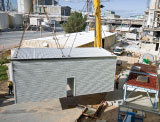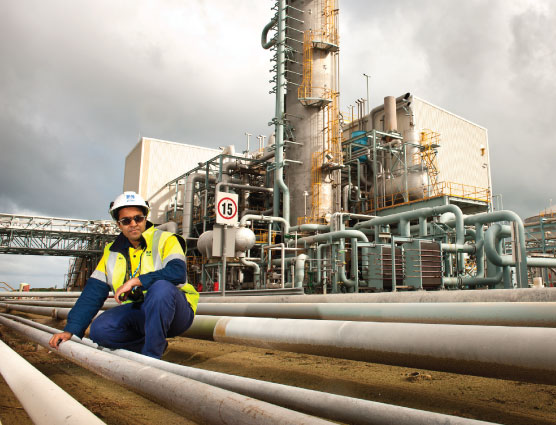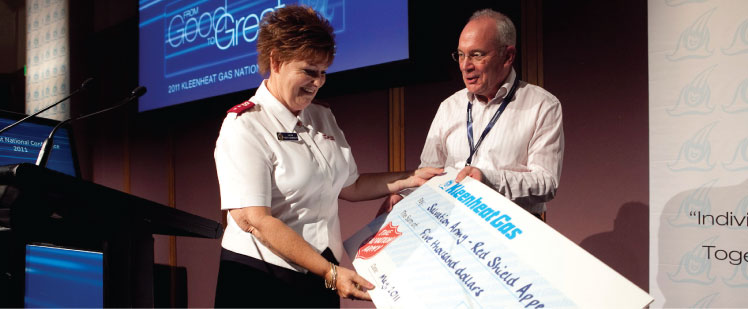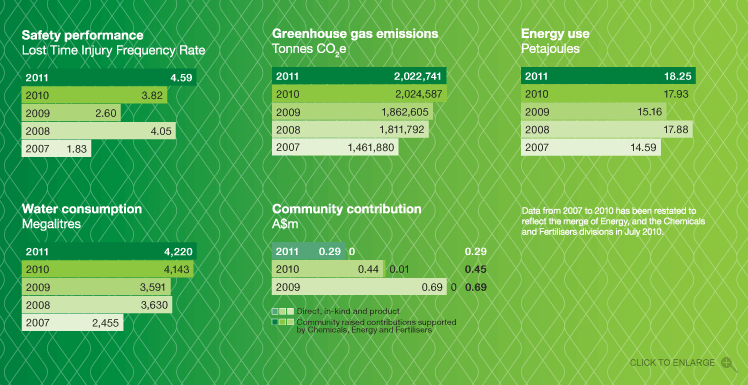Chemicals, Energy and Fertilisers
Performance overview
Priorities and outcomes
-
Area 2010 Priority Outcome 
Safety To improve the overall participation of our workforce in health and safety activities such as hazard identification, inspections and risk assessments  Achieved
AchievedWe increased our focus on safety metrics in our businesses which led to increases in team safety meetings, risk assessments, task observations and hazard identification in the workplace 
Safety To improve compliance to regulations of all major hazard facilities (MHF) and develop our KPIs to track process safety performance  Achieved
AchievedSafety reports approved by regulators for our ammonia/ammonium nitrate and Kleenheat Gas production facilities
Work is underway on safety reports for Kleenheat's Deer Park (Victoria) facility, and Australian Vinyls in Laverton North, Victoria
Australian Gold Reagents achieved recertification with the International Cyanide Management Code (ICMI)
People To improve training materials and delivery to support the initial induction, skill development and competence of our workforce  Partially achieved
Partially achievedTwo new training advisors were appointed for Kleenheat Gas
A manager was appointed to improve training for fertiliser operational and maintenance employees
Training modules for operators in sodium cyanide and fertilisers operations were updated
Divisional leadership programs were launched nationally
Environment To continue to manage legacy waste and contamination issues  Achieved
AchievedGroundwater monitoring at CSBP's site in Bayswater (Western Australia) continued and environmental remediation reports were drafted
Contaminated soil was excavated from CSBP's site in Bunbury, Western Australia
Investigations of historic contamination at CSBP Kwinana continued
People To integrate and improve documentation and the systems that facilitate their access  Partially achieved
Partially achievedA new document management system was implemented at the Kleenheat production facility in Kwinana, and work to introduce the system to other parts of Kleenheat Gas commenced 
Community To contribute to and engage with the communities in which we operate  Achieved
AchievedCommunity support activities continued
We continued our membership and involvement with key industry bodies
A public information evening was held at CSBP Kwinana to provide details about our proposed ammonium nitrate expansion project
A customer and community information campaign was implemented to support the shutdown of the Tempered Liquid Petroleum Gas (TLP) reticulation system in Armidale, New South Wales
Overview of the business
About our business
Wesfarmers Chemicals, Energy & Fertilisers (WesCEF) operates chemical, gas, power generation1 and fertiliser businesses that service sectors in both Australian and overseas markets.
Our division was created following the merger of the Energy, and Chemicals and Fertilisers divisions, announced in April 2010. As this is our first year of reporting as WesCEF, historical data was created by combining data previously reported separately by the two divisions.
We have a 50 per cent interest in an ammonium nitrate facility in Queensland (QNP), but we do not operate the business and it is not included in this report.
We have operations around Australia, and employed 1,472 people as at 30 June 2011. Our revenue in 2010/11 was $1,641 million.
Year in review
We continued our focus on the sustainable operation of our businesses for the benefit of our employees, our customers and the communities in which we operate. We remain committed to the safe operation of our facilities in a way that minimises any adverse impact.
In November 2010, CSBP released the Public Environmental Review document for its proposed ammonium nitrate expansion project for a 10-week public consultation period, and held a public information evening about the proposed project in December 2010. The WA Environmental Protection Authority released its report and recommendations for this project in July 2011 and the ministerial statement was signed by the Western Australian Minister for Environment in October 2011.
In February 2011, CSBP started trials of nitrous oxide reduction technology in one of its nitric acid plants at Kwinana (Western Australia) to help reduce greenhouse gas emissions. In 2009/10, nitrous oxide emissions represented approximately 46 per cent of the division's total carbon dioxide equivalent (CO2e) greenhouse emissions.
CSBP also completed design work and started fabrication of a regenerative thermal oxidiser that will broaden supply options for our superphosphate manufacturing operation at Kwinana, and help reduce dependence on phosphate rock from Western Sahara.
Kleenheat Gas completed a trial of American Power Group's patented dual-fuel system that converts existing diesel engines in heavy vehicles to operate on a blend of diesel and LNG. This provides lower operating costs and reduced emissions through the displacement of diesel by LNG.
We have previously reported on the performance and expansion of our nutrient-stripping wetland at CSBP Kwinana. This year, we successfully trialled the addition of organic carbon in the wetland to enhance the removal of nitrogen from wastewater prior to discharge from site.
Material issues
Our material issues are:
- continuing to improve workplace safety
- minimising greenhouse gas emissions, and further improving energy efficiency
- ensuring the efficient use of water in our operations, including the use of recycled and reclaimed water supplies
- continuing to develop, engage and retain our employees
- continuing to contribute to and engage with the communities in which we operate.
People
As at 30 June 2011 we employed 1,472 people, excluding contractors but including casual employees.
The ongoing development of our people is one of our key priorities, and during the year we launched our Capability Framework which focuses on leadership development, talent management and the development of core competencies.
During the year, we employed six apprentices and sponsored an additional 11 in our businesses.
We introduced the WesCEF Women Forums (27 per cent of our employees are female), and developed the division's Aboriginal Strategy. An Aboriginal cadetship commenced in the division in June 2011, and recruitment is currently underway for a Coordinator, Aboriginal Affairs.
In 2010/11, we recorded 55 Total Recordable Injuries (TRIs), 16 of which were Lost Time Injuries (LTIs). This compares to 83 TRIs and 16 LTIs last year. Our Total Recordable Injury Frequency Rate decreased from 19.79 to 15.77, while our Lost Time Injury Frequency Rate increased from 3.82 to 4.59.*
We increased our focus on safety metrics in our businesses which led to increased team safety meetings, risk assessments, task observations and hazard identification in the workplace. We also introduced additional safety scorecards at CSBP.
We started a phased introduction of a new safety incident reporting tool, Cintellate, to replace existing systems and provide a single incident, action management and inspection/audit tracking tool across the division.
We started developing skills and training matrices within the Kleenheat Gas business, as well as new technical training modules for the Kleenheat Gas production facility operators.
Environment
We continued a review of our environmental management systems, including the review and assessment of our environmental risks.
Kleenheat continued to participate in the WA Contaminated Sites Committee proceedings for determining responsibility for contamination at an Osborne Park (Western Australia) site, formerly occupied by Kleenheat (among others).
Emissions notifiable under the National Pollutant Inventory (NPI) were estimated, and data for the 2009/10 reporting period was submitted to government. Detailed information is available at www.npi.gov.au
Carbon, energy and water
Greenhouse emissions
Our 2010/11 Scope 1 and 2 greenhouse gas emissions were estimated at 1,875,740 tonnes of carbon dioxide equivalent (CO2e), a decrease of 2.8 per cent on last year. Of this, 46 per cent was generated from nitric acid production, 25 per cent from ammonia production, seven per cent from natural gas and diesel use in our power stations, and seven per cent from LPG and LNG production. The balance was generated from various other processes associated with our operations.
In addition, Scope 3 emissions associated with our electricity, natural gas, liquid fuel, waste and air travel were estimated to be 147,001 tonnes CO2e.
Energy use
Our net energy consumption was estimated to be 18.25 petajoules, up two per cent on last year. Our energy use is represented by natural gas (79 per cent), LNG (nine per cent), and diesel (six per cent), with other energy making up the remaining (six per cent).
Water use
Our total water consumption was 4,220 megalitres, up two per cent on last year.
We continued our use of recycled water at CSBP Kwinana, and Australian Vinyls used 130 megalitres of recycled water from its recycled water plant that was commissioned in February 2010.
Governance
Our Health, Safety and Environment team provides guidance and advice to our businesses on current and changing legislative and public policy requirements, and supports them in complying with these requirements.
As part of our operations, we manage several major hazard facilities (MHFs), and manufacture, handle and transport dangerous goods.
Australian Gold Reagents achieved recertification with the International Cyanide Management Code covering the manufacture, transport and use of sodium cyanide.
In January 2011, our sodium cyanide business received a formal letter of warning from the Department of Environment and Conservation (DEC) in Western Australia for failure to ensure the accuracy and reliability of NOx data for a minimum of 90 per cent of the operating time for the month of February 2010 from one of our sodium cyanide liquid production plants at Kwinana, as reported in last year's Sustainability Report.
During the year, CSBP reported to the DEC that a loss of containment of nitric acid occurred at CSBP Kwinana in September 2010, and also reported that the accuracy and reliability of data collected for a sodium cyanide liquid production plant NOx analyser at Kwinana in March 2011 was below licence requirement. The DEC is yet to respond to these events. CSBP has undertaken actions to address these events.
Australian Vinyls identified a number of corrective actions following the investigation of a minor injury resulting from the use of a catalyst X16 (Ethyl Chloroformate). These actions became the subject of an improvement notice following the provision of the information associated with the incident to Worksafe Victoria. All actions have been undertaken and therefore the improvement notice has been complied with.
During the year, Kleenheat Gas received two remediation notices from the Department of Mines and Petroleum in Western Australia regarding its Beach Street site in Kwinana. Both notices were complied with.
Kleenheat Gas also received three directives from the Hazardous Industries and Chemicals Branch, Workplace Health and Safety in Queensland regarding its Pinkenba site. Actions to comply with these three directives are underway and on track to be completed by their due dates.
Community
We provided support to more than 150 organisations in 2010/11 through direct financial support or through the donation of goods.
WesCEF continued support of Youth Focus, The Salvation Army, the Asthma Foundation of Western Australia and the Clontarf Foundation.
In January 2011, we announced the shutdown of the 110-year-old TLP gas reticulation system in Armidale, New South Wales. An extensive information campaign was undertaken to provide both customers and the community with information about the shutdown, and a range of subsidies and incentives were offered to help customers convert to LPG alternatives.
In late 2009, we announced an investment of almost $5 million in a regenerative thermal oxidiser (RTO) to broaden phosphate rock supply options for our superphosphate manufacturing operation at Kwinana and reduce our dependence on phosphate rock from Western Sahara. Fabrication has started, and the RTO is expected to be commissioned in late 2011. During the year, we continued to engage in dialogue with interested parties regarding the importation of phosphate rock from Western Sahara, and welcomed an invitation to meet with the International Officer for the Forum for the Future for Saharawi Women during her visit to Perth in May 2011. Unfortunately, the meeting invitation was withdrawn.

The regenerative thermal oxidiser unit being lifted into position at WesCEF's fertiliser operations in Kwinana, Western Australia.
1. On 31 August 2011, Wesfarmers completed the sale of enGen for $101 million.



Reducing greenhouse gas emissions
Nitrous oxide is a greenhouse gas emitted during the production of nitric acid, which is produced as a feedstock for ammonium nitrate production. Each unit of nitrous oxide emitted is equivalent to 310 units of carbon dioxide.
In 2009/10, nitrous oxide emissions represented approximately 46 per cent of our division's total carbon dioxide equivalent (CO2e) greenhouse emissions.
In February 2011, CSBP started a trial of new nitrous oxide abatement catalyst technology in one of its two nitric acid plants at Kwinana to help reduce our total greenhouse gas emissions.
The decision to trial the technology was announced in November 2010, ahead of the Federal Government's climate change framework announcement in February 2011.
The catalyst converts nitrous oxide to inert nitrogen and oxygen. If the initial results of the trial prove successful, a similar catalyst will be installed in the other nitric acid plant at CSBP Kwinana.
If successful, this could potentially reduce the division's total greenhouse gas emissions by more than 700,000 tonnes per year.
If the initial results of the trial prove successful, a similar catalyst will be installed in the other nitric acid plant at CSBP, Kwinana.
Left: CSBP Process Engineer Moiz Alibhai in front of the nitric acid plant in which CSBP is currently trialling nitrous oxide abatement technology.


